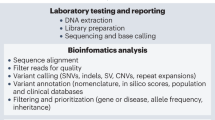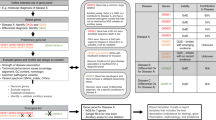Abstract
With the declining cost of sequencing and the ongoing discovery of disease genes, it is now possible to examine hundreds of genes in a single disease-targeted test. Although exome- and genome-sequencing approaches are beginning to compete, disease-targeted testing retains certain advantages and still holds a firm place in the diagnostic evaluation. Here I examine the current state of clinical disease-targeted sequencing and evaluate the benefits and challenges of incorporating sequencing tests into patient care.
This is a preview of subscription content, access via your institution
Access options
Subscribe to this journal
Receive 12 print issues and online access
$189.00 per year
only $15.75 per issue
Buy this article
- Purchase on Springer Link
- Instant access to full article PDF
Prices may be subject to local taxes which are calculated during checkout
Similar content being viewed by others
References
Yu, B., Sawyer, N. A., Chiu, C., Oefner, P. J. & Underhill, P. A. DNA mutation detection using denaturing high-performance liquid chromatography (DHPLC). Curr. Protoc. Hum. Genet. 48, 7.10.1–7.10.14 (2006).
Gowrisankar, S. et al. Evaluation of next generation sequencing of 19 dilated cardiomyopathy genes for clinical applications. J. Mol. Diagn. 12, 818–827 (2010).
Teekakirikul, P., Cox, S. W., Funke, B. & Rehm, H. L. Targeted sequencing using Affymetrix CustomSeq arrays. Curr. Protoc. Hum. Genet. 69, 7.18.1–7.18.17 (2011).
Palomaki, G. E. et al. DNA sequencing of maternal plasma reliably identifies trisomy 18 and trisomy 13 as well as Down syndrome: an international collaborative study. Genet. Med. 14, 296–305 (2012).
O'Sullivan, J. et al. A paradigm shift in the delivery of services for diagnosis of inherited retinal disease. J. Med. Genet. 49, 322–326 (2012).
Teekakirikul, P., Kelly, M. A., Rehm, H. L., Lakdawala, N. K. & Funke, B. H. Inherited cardiomyopathies: molecular genetics and clinical genetic testing in the postgenomic era. J. Mol. Diagn. 27 Dec 2012 (10.1016/j.jmoldx.2012.09.002).
Valencia, C. A. et al. Comprehensive mutation analysis for congenital muscular dystrophy: a clinical PCR-based enrichment and next-generation sequencing panel. PLoS ONE. 8, e53083 (2013).
Morel, C. F. & Clarke, J. T. The use of agalsidase alfa enzyme replacement therapy in the treatment of Fabry disease. Expert Opin. Biol. Ther. 9, 631–639 (2009).
Motwani, M., Banypersad, S., Woolfson, P. & Waldek, S. Enzyme replacement therapy improves cardiac features and severity of Fabry disease. Mol. Genet. Metab. 107, 197–202 (2012).
Ledbetter, D. H. Cytogenetic technology—genotype and phenotype. N. Engl. J. Med. 359, 1728–1730 (2008).
Ledbetter, D. H. Response to Saul and Moeschler “How best to use CGH arrays in the clinical setting”. Genet. Med. 11, 371 (2009).
Schrauwen, I. et al. A sensitive and specific diagnostic test for hearing loss using a microdroplet PCR-based approach and next generation sequencing. Am. J. Med. Genet. A 61, 145–152 (2013).
Bamshad, M. J. et al. Exome sequencing as a tool for Mendelian disease gene discovery. Nature Rev. Genet. 27, 745–755 (2011).
Francey, L. J. et al. Genome-wide SNP genotyping identifies the stereocilin (STRC) gene as a major contributor to pediatric bilateral sensorineural hearing impairment. Am. J. Med. Genet. A 158, 298–308 (2012).
Phylipsen, M. et al. Fine-tiling array CGH to improve diagnostics for α- and β-thalassemia rearrangements. Hum. Mutat. 33, 272–280 (2012).
ACMG Board of Directors. Points to consider in the clinical application of genomic sequencing. Genet. Med. 14, 759–761 (2012).
Johnston, J. J. et al. Secondary variants in individuals undergoing exome sequencing: screening of 572 individuals identifies high-penetrance mutations in cancer-susceptibility genes. Am. J. Hum. Genet. 91, 97–108 (2012).
The 1000 Genomes Project Consortium. An integrated map of genetic variation from 1,092 human genomes. Nature 491, 56–65 (2012).
Fu, W. et al. Analysis of 6,515 exomes reveals the recent origin of most human protein-coding variants. Nature 493, 216–220 (2013).
Alasti, F., Van Camp, G. & Smith, R. J. H. Pendred syndrome/DFNB4. GeneReviews [online], (updated 20 Dec 2012).
Smith, R. J. H., Gurrola, J. G. & Kelley, P. M. OTOF-related deafness. GeneReviews [online], (updated 14 Jun 2011).
Köhler, S. et al. Clinical diagnostics in human genetics with semantic similarity searches in ontologies. Am. J. Hum. Genet. 85, 457–464 (2009).
Segal, M. How doctors think, and how software can help avoid cognitive errors in diagnosis. Acta Paediatr. 96, 1720–1722 (2007).
Green, R. C. et al. Exploring concordance and discordance for return of incidental findings from clinical sequencing. Genet. Med. 14, 405–410 (2012).
Teutsch, S. M. et al. The Evaluation of Genomic Applications in Practice and Prevention (EGAPP) Initiative: methods of the EGAPP Working Group. Genet. Med. 11, 3–14 (2009).
Palomaki, G. E., McClain, M. R., Melillo, S., Hampel, H. L. & Thibodeau, S. N. EGAPP supplementary evidence review: DNA testing strategies aimed at reducing morbidity and mortality from Lynch syndrome. Genet. Med. 11, 42–65 (2009).
Veenstra, D. L. et al. Improving efficiency and relevance of evidence-based recommendations in the era of whole-genome sequencing: an EGAPP methods update. Genet. Med. 15, 14–34 (2013).
Share alike [editorial]. Nature 490, 143–144 (2012).
Baker M. One-stop shop for disease genes: NIH database integrates data from clinical genetic testing labs and literature. Nature 491, 171 (2012).
Quigley, F., Greene, M., O'Connor, D. & Kelly, F. A survey of the causes of sudden cardiac death in the under 35-year-age group. Ir. Med. J. 98, 232–235 (2005); erratum 98, 282 (2005).
Monserrat L et al. Prevalence of Fabry disease in a cohort of 508 unrelated patients with hypertrophic cardiomyopathy. J. Am. Coll. Cardiol. 50, 2399–2403 (2007).
Terryn, W. et al. Prevalence of Fabry disease in a predominantly hypertensive population with left ventricular hypertrophy. Int. J. Cardiol. 15 Jul 2012 (10.1016/j.ijcard.2012.06.069).
Acknowledgements
This work was supported in part by US National Institutes of Health grants U41HG006834 and U01HG006500.
Author information
Authors and Affiliations
Corresponding author
Ethics declarations
Competing interests
Heidi L. Rehm is employed in a not-for-profit, fee-for-service clinical laboratory of Partners Healthcare.
Related links
FURTHER INFORMATION
PowerPoint slides
Glossary
- Array-based oligo-hybridization sequencing
-
A method of DNA sequencing that uses array-conjugated oligonucleotide probes to determine the DNA sequence through differential hybridization of matched and mismatched probes at each base in a stretch of DNA.
- Cardiomyopathy
-
A pathological state of the cardiac muscle that can result in increased muscle mass (that is, hypertrophic cardiomyopathy), enlargement of the cardiac chambers (that is, dilated cardiomyopathy) or fatty and fibrotic tissue replacement associated with decreased right ventricular wall movement and arrhythmia (that is, arrhythmogenic right ventricular cardiomyopathy).
- Coverage
-
The quantity of DNA sequence reads that overlay a defined region of DNA sequence; higher coverage generally allows more accurate detection of sequence variants.
- Cytogenomic arrays
-
Microarray technologies used to assess the entire nuclear genome for gains and losses of chromosome segments.
- Fabry's disease
-
A rare genetic disorder primarily involving the heart, kidneys and neurosensory system that is caused by lysosomal storage dysfunction owing to the absence of functional α-galactosidase enzyme.
- Lynch syndrome
-
A form of inherited cancer, traditionally referred to as hereditary nonpolyposis colon cancer, that leads to increased risk for tumours of the digestive track, particularly the colon.
- Muscular dystrophy
-
A muscle disorder in which defects in muscle proteins lead to gradual weakening of muscle function owing to degeneration of muscle cells.
- Otoacoustic emission testing
-
A test of hearing function that involves the analysis of minute sounds produced by cells in the cochlear hearing organ in response to a sound input.
- Retinitis pigmentosa
-
A form of retinal degeneration in which inherited defects in the photoreceptor cells lead to gradual vision loss.
- Sanger sequencing
-
A method developed by Frederick Sanger to determine the sequence of DNA through the random incorporation of labelled dideoxynucleotides that cause nucleotide-specific chain termination.
- Temporal bone evaluation
-
The use of CT or MRI imaging to examine the bony structures surrounding the inner ear organ.
Rights and permissions
About this article
Cite this article
Rehm, H. Disease-targeted sequencing: a cornerstone in the clinic. Nat Rev Genet 14, 295–300 (2013). https://doi.org/10.1038/nrg3463
Published:
Issue Date:
DOI: https://doi.org/10.1038/nrg3463
This article is cited by
-
Utility of next-generation sequencing in genetic testing and counseling of disorders involving the musculoskeletal system—trends observed from a single genetic unit
Journal of Orthopaedic Surgery and Research (2022)
-
Intellectual disability genomics: current state, pitfalls and future challenges
BMC Genomics (2021)
-
Clinical and technical assessment of MedExome vs. NGS panels in patients with suspected genetic disorders in Southwestern Ontario
Journal of Human Genetics (2021)
-
Molecular classification of blood and bleeding disorder genes
npj Genomic Medicine (2021)
-
IonCRAM: a reference-based compression tool for ion torrent sequence files
BMC Bioinformatics (2020)



